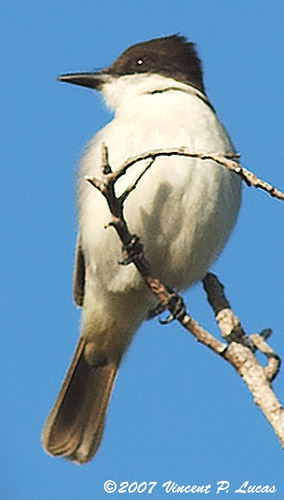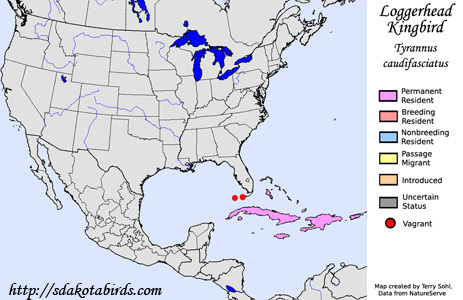| Length: 9 inches | Wingspan: 15 inches | Seasonality: Non-resident in South Dakota |
| ID Keys: Gray upperparts, white underparts with a slight buffy wash on the belly, large dark head, white-tipped tail | ||
 The
Loggerhead Kingbird is a large flycatcher species of the Caribbean, with
significant populations close to the United States in the Bahamas and Cuba.
In the United States, they are known from several sightings in Florida, with
most sightings in the Florida Keys and Dry Tortugas. The species was
unknown in the United States until March of 2007, when a bird was found in
Fort Zachary Taylor State Historic Site in Key West, Florida. The
species has since been found multiple times at the same location, and has
also been found elsewhere in Florida.
The
Loggerhead Kingbird is a large flycatcher species of the Caribbean, with
significant populations close to the United States in the Bahamas and Cuba.
In the United States, they are known from several sightings in Florida, with
most sightings in the Florida Keys and Dry Tortugas. The species was
unknown in the United States until March of 2007, when a bird was found in
Fort Zachary Taylor State Historic Site in Key West, Florida. The
species has since been found multiple times at the same location, and has
also been found elsewhere in Florida.
Habitat: Found in tropical and subtropical forest, both at lower elevations as well as montane forest. Prefers open and semi-open forests, including around forest edges and clearings.
Diet: Feeds on insects and other small invertebrates. Will also feed on fruits and berries, and on occasionally will take small vertebrates such as small lizards.
Behavior: Most often forages by observing from a perch, flying out to capture insects that it spots, and returning to the perch to consume its prey.
Nesting: The Loggerhead Kingbird builds a loose nest of sticks, bark strips, and other plant materials, and lines the nest with grasses, mosses, and other finer and softer material. The female usually lays 3 to 5 eggs, and she alone incubates the eggs. Both parents help feed the young after they hatch. The young fledge by 20 days after hatching.
Song: The most often heard vocalization is a rolling cheeeerup
Migration: Considered a permanent resident in their normal range in the Caribbean.
Interactive eBird Map: Click here to access an interactive eBird map of Loggerhead Kingbird sightings
Similar Species: When they stray to the United States, they are most likely to be confused with the Eastern Kingbird. The heavier bill and larger head of the Loggerhead Kingbird are the primary field marks to distinguish it from the Eastern Kingbird.
Conservation Status: Populations are found over a reasonably wide geographic area and appear to be stable. The IUCN lists the Loggerhead Kingbird as a species of "Least Concern".
Further Information: 1) BirdLilfe International - Loggerhead Kingbird
2) Audubon Guide - Loggerhead Kingbird
3) Cornell's NeoTropical Birds - Loggerhead Kingbird
Photo Information: Photo taken by Vincent P. Lucas - March 18th, 2007 - Fort Zachary Taylor State Historic Site, Key West, Florida - Photo licensed under Creative Commons Attribution 2.0 Generic License.
| Click below for a higher-resolution map |
 |
| South Dakota Status: Non-resident in South Dakota |
Additional Loggerhead Kingbird Photos (coming soon!!)
